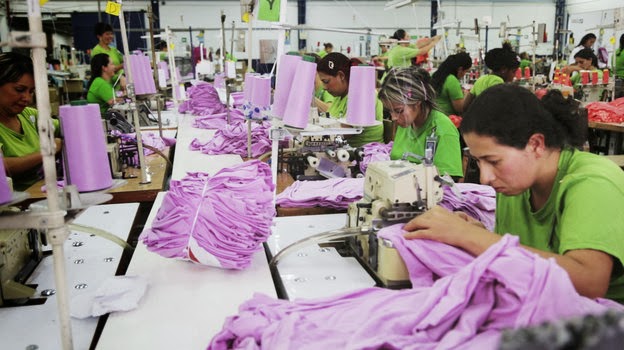Please help me with my math because I don't understand why Colombian labor costs more than Bangladeshi labor. They say:
The Planet Money men's T-shirt was made in Bangladesh, by workers who make about $3 a day, with overtime. The Planet Money women's T-shirt was made in Colombia, by workers who make roughly $13 a day, without overtime.Later, they say:
In Bangladesh, on one sewing line for our T-shirt, 32 people can make about 80 shirts per hour. One sewing line in Colombia has eight people and can make about 140 T-shirts per hour.In another segment, they say that the Bangladeshi workers put in 6 10-hour days per week. Assuming that Colombian workers put in 8 hours per day (they have time left over to run side businesses so they have probably work fewer hours in the factory):
Bangladesh labor cost per shirt:
= ($3 per person per day/10 hours per day) * (32 people/80 shirts per hour)
= $0.12 labor/shirt
Colombia labor cost per shirt:
= ($13 per person per day/8 hours per day) * (8 people/140 shirts per hour)
= $0.09 labor/shirt
(I'm sorry that the fractional formatting is such a mess, but Blogger doesn't accept the MathML extension and I can't figure out a way to inject MathJax into Blogger.)
Jockey also says that the Colombia factory turns jobs around more quickly, can make smaller lots (to minimize the amount Jockey has to mark down due to lack of demand), and shipping is $0.10 from Bangladesh and only $0.07 from Colombia. This makes Colombia the winner at $0.16 vs $0.22.
So why does Jockey say that they can save 20-30% by producing in Bangladesh instead of Colombia? What data am I missing? Or is my math wrong?
BTW, both the Colombian factory workers and the African shirt recyclers say that Americans must be gigantic (fat) people based on the sizes of our t-shirts. Hmmm. I guess we are over-consuming more than t-shirts.
Followup:
The Planet Money published data is definitely incomplete. They did report that the Bangladesh factory did a few more steps, but did not elaborate. I'll just assume that Jockey did their math correctly with their proprietary $ numbers. This story did illustrate for me how much this global supply chain depends on cheap and reliable shipping. Add time and cost to shipping, and savings evaporate.It truly is an industry on roller skates seeking an instantaneous local minimum in cost. People are treated like the commodities they make. Why does it have to be so? Is there anything we can do to change this system?

Jockey is presumably paying the contractor, not the stitchers. The greater productivity of the Columbian stitchers may reflect greater capital investment by the Columbian contractor, so there may be other costs. Taxes and real estate maybe higher.
ReplyDeleteColombia...
ReplyDeleteThanks for the spelling help! I corrected my mistake.
DeleteCould you correct mine too?
DeleteThis comment has been removed by a blog administrator.
DeleteNope, I can't edit your comment. But, you can delete your comment and repost a correction.
DeleteMaybe they don't take multiplication in the textile trade because I get Colombia too. Perhaps there are payoffs or political issues involved?
ReplyDeletePlanet Money compared Colombia to Bangladesh, but Jockey didn't say they were leaving Colombia for Bangladesh; they are moving to "several other countries." So there may be a third country with different wage/productivity numbers.
ReplyDeleteIt could be that the Bangladesh price includes fabric and trim (thread, labels etc) and the Colombian one doesn't.
ReplyDeleteAlso omitted: we now have a free trade agreement with Colombia so landed cost should be even lower.